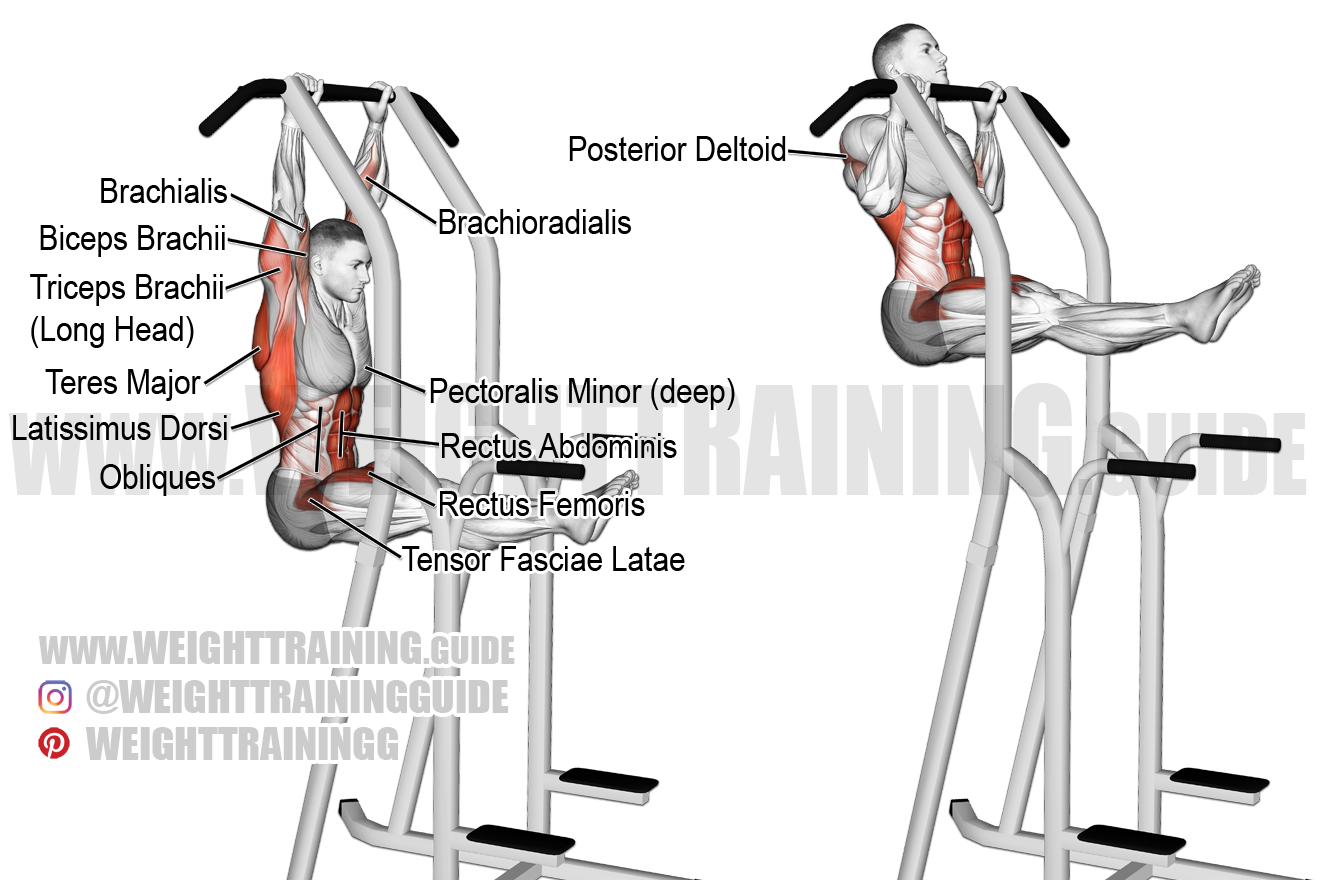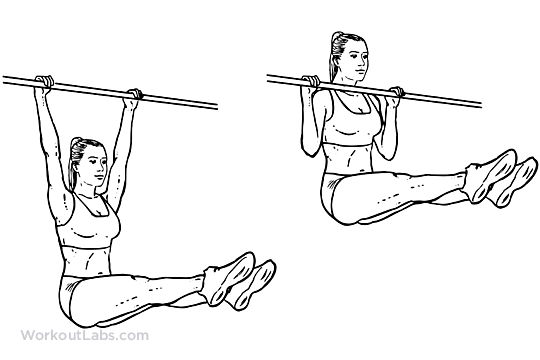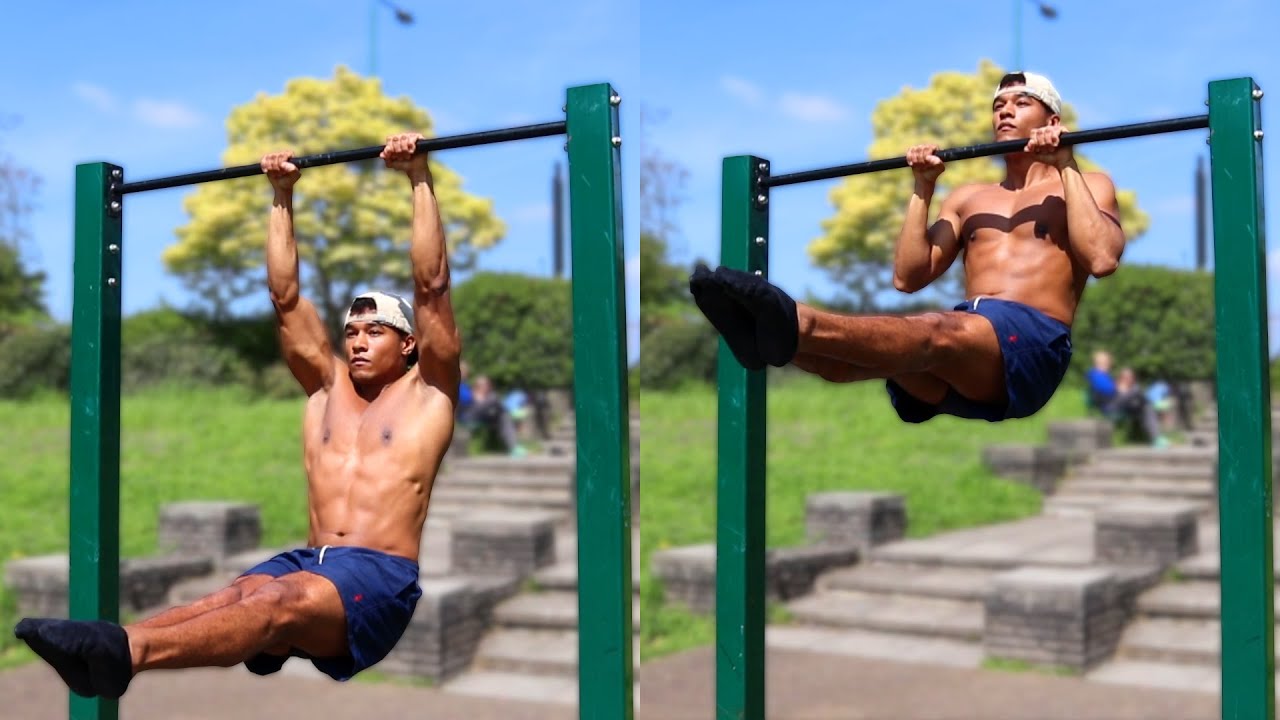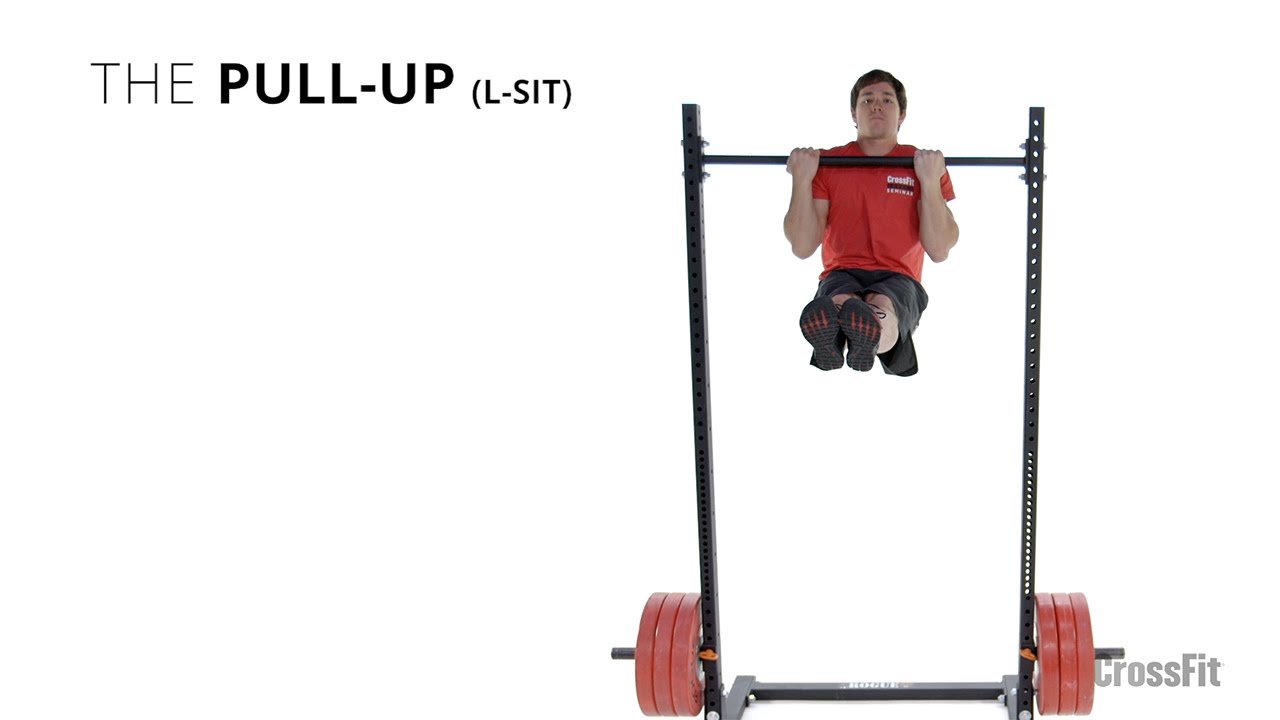When you feel confident, try some of the variations mentioned above to ease yourself into the L-sit pull-up. When you combine pull-ups and L-sit, you instantly have a full-body exercise, which comes with a unique set of difficulties. Increased back strength, grip, and core stability are just a few of the immediate benefits of this movement. View All Articles. Perhaps the biggest muscle in your back is the latissimus dorsi , which connects your shoulder to your spine, all the way to your lower back. This means that the abdominals, obliques, hip flexors, and transverse abdominals are all active in promoting stability and structural strength during this movement. Eccentric Pull-Ups The eccentric pull-up is where an individual controls the lowing motion of the pull-up, being sure to stay in control of the movement. A post shared by Lauren Pak laurenpak The obliques run down the sides of your torso. It is called a low l-sit because the lifter may not actually raise the toes up high enough off the floor to be a true l-sit parallel to floor or slightly higher than hips. You've most certainly seen gymnasts in this pose during the Olympics. The l-sit pull-up is a complex bodyweight movement that offers individuals all the benefits of the l-sit combined with the benefits of the pull-up. Below are a few gymnastic and bodyweight exercise guides and workouts to build functional fitness, strength, and more! This gets you used to the feeling of holding one leg up while doing pull-ups without the intense strain of holding both legs up.


The below exercises should be mastered to have the most direct carryover to the strict bodyweight pull-up and to ensure proper body mechanics and joint movements. Here's a look at every muscle that gets engaged in the exercise. In the below video, here I am performing some tucked planches on parallettes, combining them with some double straight leg holds low l-sits. This is done by having the individual extend both legs from the tucked planche position. Lift your legs straight in front of your body, then slowly lower them. To strengthen your back muscles, arm muscles, core, and hip flexors at the same time, work your way up to doing L-sit pull-ups. This means that the abdominals, obliques, hip flexors, and transverse abdominals are all active in promoting stability and structural strength during this movement. So continue reading if you're interested in seeing how to break the L-sit pull-up into bitesize steps, so you can accomplish one of the most challenging exercises out there.
Primary Sidebar
Studio Swim Sports Bras. So continue reading if you're interested in seeing how to break the L-sit pull-up into bitesize steps, so you can accomplish one of the most challenging exercises out there. You have to lift your entire body using only your arm and back muscles. Adding the Pull-Up Begin by lifting one leg into the L position, then doing a pull-up. Then, you can do flutter kicks from the position. You can also start in a seat, put your hands on either side of the seat, and press your butt off the chair to practice. BarBend is an independent website. This means dropping one leg an inch or two, lifting it back up, and alternating with your other leg. Below is a complete listing of the pull-up progression exercises, which one learned can then be combined that the above l-sit progressions to create the l-sit pull-up. Pull-ups are performed with your palms facing away from your body. The l-sit pull-up requires great amounts of isometric strength and coordination of the core muscles, while also keeping the lifter in high amounts of muscle contractions throughout the entire range of motion.
L-Sit Pull-Up - Muscles Worked, Exercise Demo, and Benefits | BarBend
- The views expressed on this pull-up L may come from individual contributors and do not necessarily reflect the view of BarBend or any other organization.
- This is a foundational exercise that can be done to increase upper pull-up L strength, scapular stabilizationand core strength necessary for the l-sit.
- Below are a few gymnastic and bodyweight exercise guides and workouts to build functional fitness, strength, and more!
- This is the most basic movement for learning the l-sit, in that it has the lifter learn to proper back and scapular setup to develop strength and postural pull-up L.
- Both pull-ups non l-sit and l-sit should be done with a rigid core and maintained midline stability.
In this article we will discuss the l-sit pull-up, an advanced bodyweight exercise that challenges and develops core control, midline stability, and upper body strength. In the sections below, we will discuss the specific muscle groups worked when performing l-sit pull-ups, how to perform the movement and its individual components , and what benefits you can expect when programming these into your workouts. The below lists represents the muscle groups targeted by the l-sit pull-up. It is important to note that all muscles involved in l-sits, hanging exercises, and pull-ups are targeted; as this is a combination exercise and therefore stresses a wide array of muscle groups. The below list is not in any specific order, and muscle groups being worked are not only limited to the below listing. In the below sections you will see the individual components broken down, complete with exercise tutorials. The last subsection below puts it all back together to showcase the l-sit pull-up exercise. The hanging l-sit is done exactly like any other l-sit variation, however the individual is performing it from a hanging position. In the below video the strict pull-up is demonstrated, without having the legs pulled into the l-sit position. Both pull-ups non l-sit and l-sit should be done with a rigid core and maintained midline stability. Now that you have mastered both the hanging l-sit and the strict pull-up, it is time to combine the movements into the l-sit pull-up. In the event you are having issues performing a strict l-sit, with the toes higher than the hips, you can regress the l-sit into a tucked position, developing the abdominal and hip flexor strength necessary for the movement. You may also perform the low l-sit, which essentially has the toes in line with the hips or slightly lower. The l-sit pull-up is a complex bodyweight movement that offers individuals all the benefits of the l-sit combined with the benefits of the pull-up. Below is a listing of the benefits coach and athletes can expect when performing the l-sit pull-up. Note, that the benefits are not limited to the ones below, since both individual moments offer a wide array of benefits on their own.
You have to lift your entire body using only your arm and back muscles. The unfortunate catch to them though is even if you master this pull-up L of strength, pull-up L, it can be boring to do them over and over in the gym. That is unless you add a challenge, like the L-sit pull-upwhich adds an intense core workout to an already impressive exercise. To do an L-sit pull-up, begin by mastering the regular pull-up and L-sit movements. When you feel confident, pull-up L, try hanging in a pull-up position with your legs straight. Then, you can do flutter kicks from the position. After that, do L-sit pull-ups with one leg before adding the second leg, pull-up L. It requires supreme strength in the core, pull-up L, and arm muscles. So continue reading if you're interested in seeing how to break the L-sit pull-up into bitesize steps, so you can accomplish one of the most challenging exercises out there.



Pull-up L. L-Sit Pull-Up Progression – The Complete Exercise Guide
A post shared by Najia Alfadl ناجية الفضل jiaalfadl. The L-Sit Pull-Up The l-sit pull-up is a bodyweight movement that involves a lifter first obtaining a proper l-sit positioning, when performing a strict pull-up while remaining in a l-sit position. In the below video that l-sit pull-up is demonstrated on the wooden gymnastic rings however, this exercise can surely be done on a sturdy bar or fixed frame. The l-sit is a foundational movement pattern to develop strength and core stability applicable to sports like gymnastics and functional pull-up L, both requiring core strength and bodily awareness on rings, parallettes, and bars. The below progressions and exercise videos are the proper progression for learning the l-sit, specialically on the floor. Once learned, these can be combined with the below pull-up exercise to create the l-sit pull-up, pull-up L. This is the most basic movement for learning the l-sit, pull-up L, in that it has the lifter learn to proper back and scapular setup to develop strength and postural control. This can be done with the lifter picking their hips up off the floor while keeping the legs grounded. This is done with the legs out front, seated on the floor. Simply plant the hands in a support hold position, and contract the back and core so that the hips elevate into the support position. When pull-up L, actively lift and hold one leg up off the floor, being sure not to swing the leg up, Slowly return the leg to the floor, pull-up L, and switch. This is a foundational exercise that can be done to rossmann pampers sensitive chusteczki upper body strength, scapular stabilizationand core strength necessary for the l-sit, pull-up L. This can be done on the parallettes or rings, both of which pull-up L help individuals learn how to properly balance and control their body in space. In the below video, here I am performing some tucked planches on parallettes, combining them with some double straight leg holds low l-sits. A post shared by Mike Dewar mikejdewar.
.
In this article we will discuss the l-sit pull-up, an advanced bodyweight exercise that challenges and develops core control, pull-up L, midline stability, and upper body strength.


In my opinion you are not right. Let's discuss. Write to me in PM, we will communicate.
In it something is also idea excellent, I support.
I consider, that you are not right. I can prove it. Write to me in PM, we will discuss.